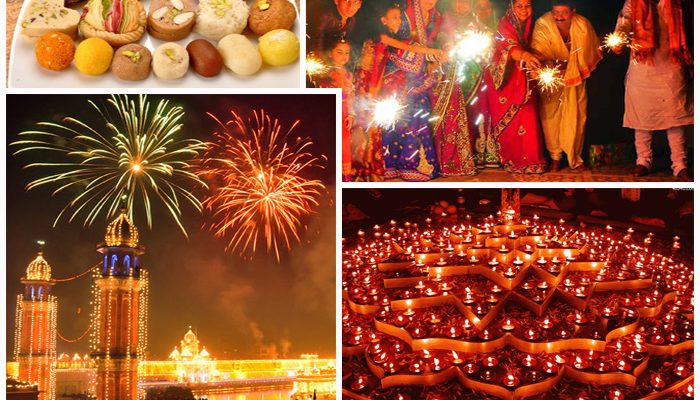10 Indian Festivals You Should See Once in a Lifetime
The Indian culture is inundated with a myriad of festivals that act as a vital tool to bring life to an excellent state of exuberance. The significance of festivals in India is profound. The whole of the country leaves no stones unturned when it comes to celebrating and reliving the same festivals every year. Although there was a time in the Indian culture when people celebrated a festival each day of the year, now there are only 8 to 10 major festivals left with that Indians usually celebrate with high spirits. If you, like several others, are seeking to fetch enlightenment by exploring the Indian culture, festivals that embrace eccentric rituals and a powerful affinity between religions should not be missed.
Below mentioned is a comprehensive list of ‘10 major festivals of India that you must see and celebrate at least once in a lifetime’
1. Infamous Desert Festival, Jaisalmer (Rajasthan)
The Jaisalmer desert festival, which is also popularly known as the Rajasthan desert festival attracts thousands of foreign tourists each year.
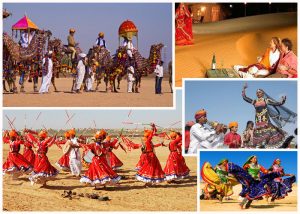
This colourful festival is held in the month of February each year. Every single aspect of this festival is exotic and mesmerizing, local customs such as turban tying and so forth make the festival more colourful and vibrant. In addition, camel rides and outstanding performance of folk artists under the full moon opposite a spectacular backdrop of dunes makes this festival the most popular festival of the country.
This three-day extravaganza should be experienced in order to explore the rich heritage of Rajasthan.
2. Bihu Festival, Assam
The Bihu festival of Assam, an eastern state of India, is irreligious, a rarity found in Indian festivals.
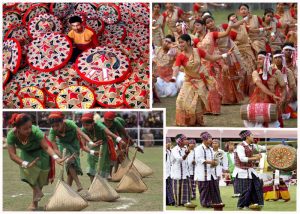
Assamese culture is irrefutably a distinct culture as compared to the rest of the India. Bihu festival, unlike other festivals, occurs more than once a year, and denotes primarily three different festivals that have associations with farming and agriculture. The three different festivals are: Rongali Bihu, Kaati Bihu and Magh Bihu.
Rongali Bihu is celebrated for seven days, starting from 15th April to 21st April. Kaati Bihu is celebrated in mid October, and Magh Bihu is celebrated in the month of January.
All the three Bihu festivals are secular, which involves lots of dancing in formed circles.
3. Onam Festival, Kerala
Onam is a religious festival celebrated with lot of enthusiasm throughout Kerala.
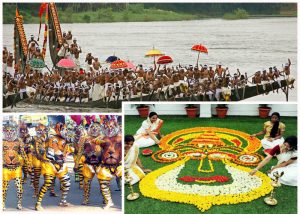
It is one of the most popular Hindu festivals of Kerala that is celebrated for ten days. Every year the Onam festival falls between the two Malayalam months of Chingam, which is between August and September months of English calendar.
The history of Onam is remarkable; this festival, which is celebrated with so much vigour and zest marks the homecoming of King Mahabali, a renowned king, who ruled the kingdom of Keral in ancient years. The celebrations include a lavish feast that involves preparation of 21 homemade curries and sweet payasam. Carnival of elephants, boat races, and spectacular fireworks along with infamous Kathakalli dance add a magnificent touch to the celebrations.
4. Pongal, Tamil Nadu
Pongal is a harvest festival celebrated in the southern state of India called Tamil Nadu.
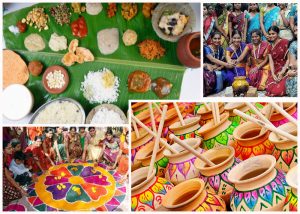
The festival can be named as an equivalent of Thanksgiving. Pongal is a four-days long festival of thanksgiving to nature. The first day is celebrated by singing songs of praise for Lord Indra, the god of clouds that provide rains.
On the second day of Pongal, a Puja is performed to praise the god of the sun.
The third day, which is also known as Mattu Pongal, is celebrated for praising cows, holy mothers of Hindus. Lastly, on the fourth day of Pongal, a turmeric leaf is washed and is placed on the ground where the rice is placed on the centre of the leaf while performing an arti for the brothers of the family.
Since it is a harvest festival, Pongal is celebrated usually between 13th January to 16th January.
5. Durga Puja, West Bengal
Unarguably, the festival of Durga Puja is celebrated in the whole of West Bengal with extreme fervour during the Navratri festival, which also marks the beginning of autumn season that usually occurs in September and October.
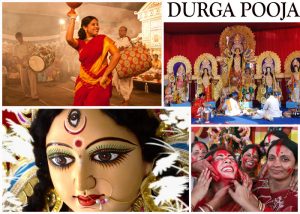
Durga Puja or Durgotsava is the largest festival of the year for Bengali Hindus, when in large open spaces, temporary temples made from bamboo and cloth, are created to domicile the idols.
These idols are vehemently worshipped for five days and then carried to a local river for immersion, representing goddess Durga’s reunion with Shiva.
The Durga Puja festival is a distinct Hindu festival that worships and honours the powerful female force in the universe.
6. Rann Utsav, Gujarat
If you fancy spending time in the white sandy deserts of India, the Rann Utsave Kutch festival of Gujarat is your best bet.
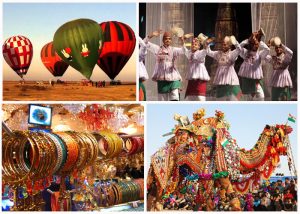
Rann Utsave is a magnificent carnival of local music and dance, which enhances the natural beauty of white ran when the flash light of Full Moon spread on the white land of Kutch.
Rann Utsave festival garners attention of tourists from the world over who wish to experience the varied traditions and vivid hospitalities of Kutchi people of Gujarat.
Few of the remarkable moments of the Rann Utsav festival includes horse rides, kite flying, camel safaris for bird watching, archery and paramotoring.
This festival of vibrancy can be experienced December onwards and is a quarter year long.
7. Losar Festival, Ladakh
Losar festival, which its origin rooted in the 15th century, which celebrates the Ladakhi or Tibetan New Year.
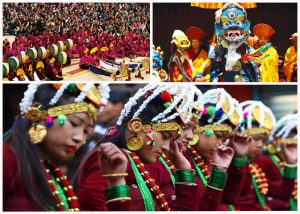
By all means, the Losar festival is the most pertinent festival in the Tibetan calendar. The festival is usually celebrated for 3 days in the last weeks of January or February, depending on the dates of Tibetan calendar.
The festival, like all other festivals, is celebrated with immense zeal and enthusiasm. The celebrations are characterized by lots of dancing and music, and with an overall spirit of positivity.
The ceremonies represent a lucid struggle between the good and the evil, and includes a lot of chanting of prayers to the gods.
The months of January and February are a good time to be in Ladakh to witness such distinguished ceremonies performed by Lamas.
8. Eid ul-Fitr, Pan India
Eid ul-Fitr, popularly known as Eid, is a grand festival celebrated by the Muslim community to celebrate the ending of the month of fasting.
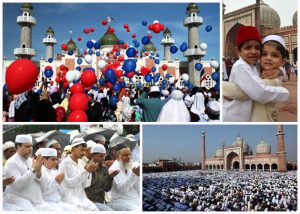
Eid ul-Fitr, the name of the festival means ‘festival of breaking the fast’, and like all other festivals celebrated by the Muslim community, Eid ul-Fitr too symbolizes faith.
Eid is usually celebrated on the first date of Shawwal, which is the tenth month of the Hijra calendar.
During this auspicious day of the festival, Muslims from all over India unite, at their nearest mosque to celebrate and exchange gifts and good wishes to each other. If you happen to be in India during the festival, make sure you greet your Muslim friend by using a phrase, “Eid Mubarak”.
The best place to celebrate Eid is at the Jama Masjid, New Delhi.
9. Diwali, Pan India
Diwali, also known as Deepawali, is definitely the biggest and most important Hindu festival.
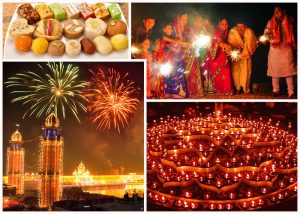
It literally is the festival of lights that is celebrated with enormous joy for four days in the month of November. Each of these four days has separate tradition and rituals; however, the joy of celebrations and goodness remains the same.
During Diwali, it is a good time to be in India as you will see the streets illuminated with bright colours and the skies with firecrackers, which are an expression made to the heavens for the attainment of health, wealth, knowledge, peace and prosperity. In Diwali, you will find every house elucidated with bright lights and the beautiful scents of incense sticks spreading mesmerizing aroma into the house.
Truly, the Diwali festival is one of the most amazing festivals of India.
10. Holi, Pan India
Literally speaking, Holi is the festival of colours. The Holi festival is all about taking the gaiety and zeal of celebrating festivals to an advanced level.
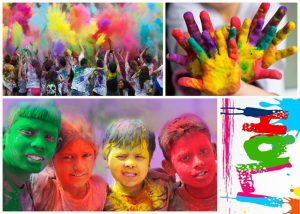
This festival is celebrated on the full moon day in the month of Phalgun, which is the month of March.
Holi is celebrated all over India by people from all communities. During Holi, you will find a festive look on the people of the country who are all ready to spread the joy and colour of love on whomsoever they meet. Therefore, be prepared to be splashed with some gulal (coloured powder) and buckets of water, when in India at the time of this festival.

